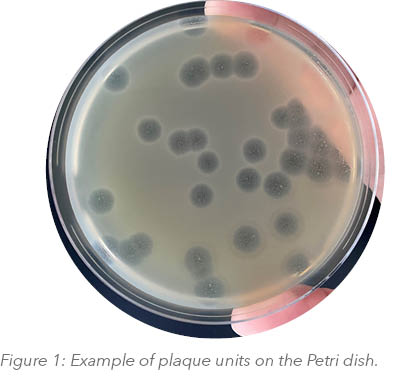Tracking the Unseen: The identification of somatic Coliphages in all water types
Published: June 2024
Download PDF
EnviroMail_18_Europe_Tracking The Unseen: The Indentification of Somatic Coliphages in All Water Types

Given the ever-increasing demands on drinking water quality and societal pressure for the reuse of treated wastewater, somatic coliphages are being monitored as novel indicators for evaluating the efficiency of water treatment and purification processes. Therefore, it is highly important to monitor their presence in specific types of water, particularly water intended for human consumption.
Introduction
Somatic coliphages are currently a significant topic in the realm of water quality control, as they exhibit certain morphological similarities to human enteric viruses and may serve as potential indicator organisms for viral contamination in water. Somatic coliphages are viruses that infect bacteria such as Escherichia coli and are, therefore, ideal indicators of faecal contamination in water. Although somatic coliphages are not pathogenic to humans, they thrive in the same conditions and exhibit very similar behaviour to viruses that are already hazardous to humans. These pathogenic, so-called enteric viruses can cause highly unpleasant infectious diseases of the digestive tract in humans. Consequently, if somatic coliphages are detected in the analysed water, there is a high probability that pathogenic viruses are also present in the water.

Why is Coliphages Testing Essential?
Coliphages play a crucial role as an indicator of water quality. Their presence can signal potential risks to public health, such as the presence of enteric viruses and bacteria.
Monitoring somatic coliphages serves as an effective early warning system against faecal contamination in water supplies. When higher levels of these viruses are detected, it prompts further investigations and interventions, thereby aiding in the prevention of waterborne diseases. Moreover, tracking somatic coliphage levels is essential for assessing the effectiveness of water treatment processes, including disinfection and filtration, thus safeguarding water quality.
Ensuring compliance with regulatory requirements and standards for the sanitary quality of drinking and hot water is another critical aspect protecting the public health. The study of somatic coliphages and their behaviour in the environment contributes to epidemiological screening. Such a research provides valuable insights into the surveillance of waterborne diseases and can inform about strategies for diseases prevention. Understanding the patterns and behaviours of coliphages in different environmental conditions enhances our ability to predict and mitigate potential Figure 1: Example of plaque units on the Petri dish. outbreaks.
Legislation
The Directive of the European Parliament and of the Council (EU) 2020/2184 from 16 December 2020 on the quality of water intended for human consumption came into force on 12 January 2021, which is a completely recast amendment to the Directive 98/83/EC. The implementation of this Directive into national legislation was planned for the end of 2022 / 2023. Somatic coliphages are also mentioned in the Regulation 2020/741 of the European Parliament and of the Council (EU) of 25 May 2020 on minimum requirements for water reuse, which should provide Member States with relatively simple rules for the reuse of treated urban water.
The Methodology for Somatic Coliphages Determination
Since somatic coliphages are viruses, water analysis is carried out in a completely different way compared to determination of bacterial parameters. The analysis is very complex and consists of several subsequent steps, where it is necessary to adhere to the exact time frame and specific conditions.

Best Sampling and Transportation Practise
For the proper execution of the analysis and to deliver high-quality and reliable results to clients, it is essential to ensure:
- Validated matrices: drinking, raw, bottled, surface, ground, processing and waste water.
 Use the correct sample container: for coliphages analysis the 500mL white plastic container filled with sodium thiosulphate (this solution neutralises chlorine from water pipes, preventing the death of live microorganisms and phages that are sensitive to the presence of chlorine, and thereby avoiding the reporting of false negative results).
Use the correct sample container: for coliphages analysis the 500mL white plastic container filled with sodium thiosulphate (this solution neutralises chlorine from water pipes, preventing the death of live microorganisms and phages that are sensitive to the presence of chlorine, and thereby avoiding the reporting of false negative results).- Minimum amount of sample: 200 mL of tested water
- Compliance with appropriate conditions during sample transport to the lab must be ensured: cooling the sample in the range 4 - 8°C.
The analysis must be performed within three days (Holding Time 72 hours) of sampling. For this reason, samples must be delivered to the laboratory no later than Thursday morning in the given week.
Evaluation of Cultivation: Determination of Plaque Units (unit PFU - Plaque Forming Unit)

(A) An optimal number of plaque units
for counting and evaluation.
(B) Borderline number of plaque units which
can be counted and evaluated. Further dilution
of sample is needed, and membrane filtration
method is not suitable.
(C) Sample is too contaminated for plaque units
to be enumerated and evaluated. Overgrown plates
are discarded and sample dillution must be performed
prior the next analysis. Membrane filtration method
is not suitable.
References
- Singh S., Pitchers R., Hassard F.: Coliphages as viral indicators of sanitary significance for drinking water. Frontiers in Microbiology (2022), 13.
DOI 10.3389/fmicb.2022.941532 - Zuzakova J., Janak D., Rihova Ambrozova J.: Concentration and enumeration methods of somatic coliphages in water samples. Vodohospodarske technicko-ekonomicke informace (2021), 63 (1), 3-13.
DOI 10.46555/VTEI.2020.11.002 - Jofre J., Lucena F., Blanch A.R., Muniesa M.: Coliphages as model orgasisms in the characterization and management of water resources. Water (2016), 8, 199.
DOI 10.3390/w8050199


